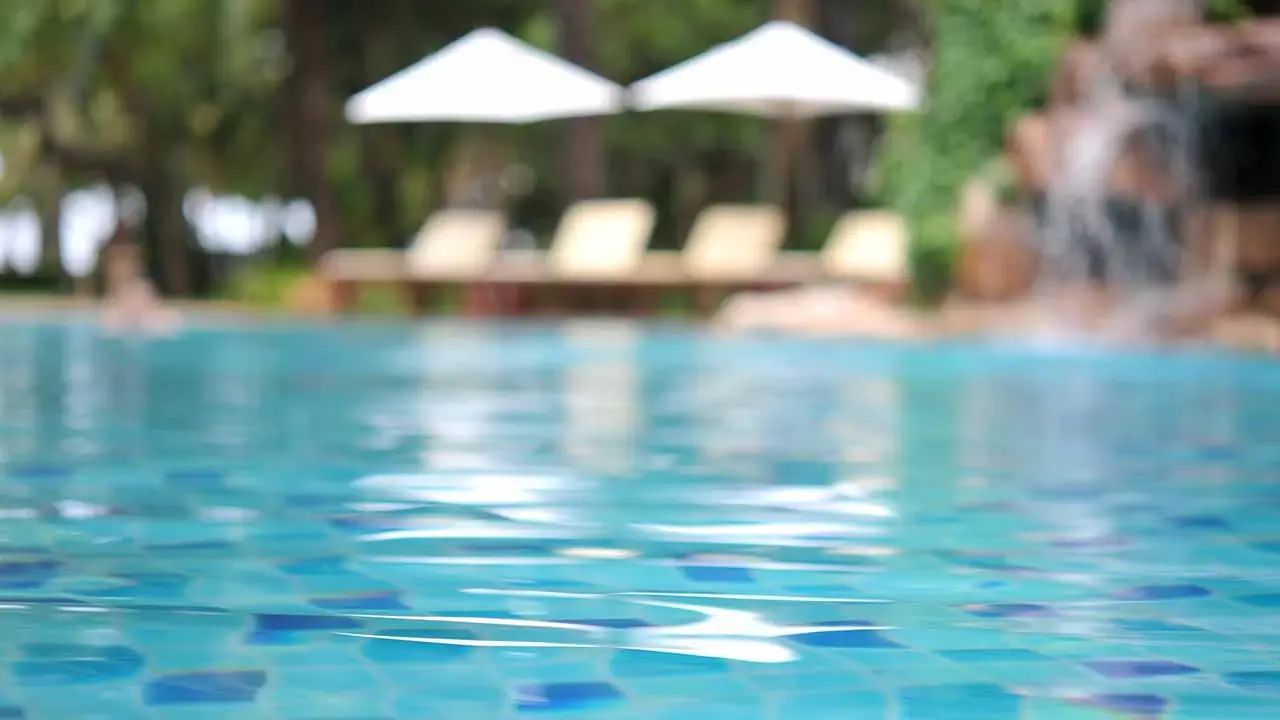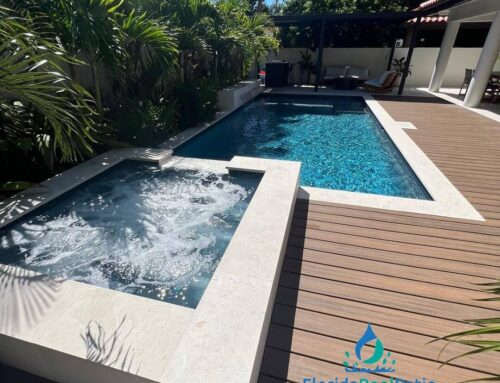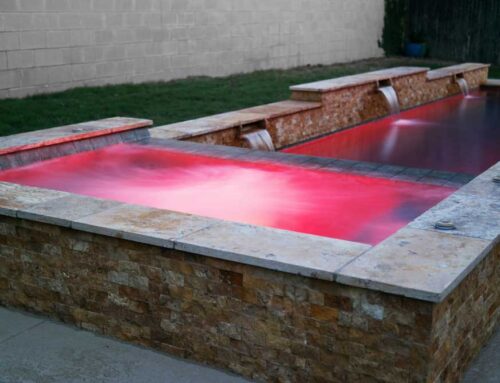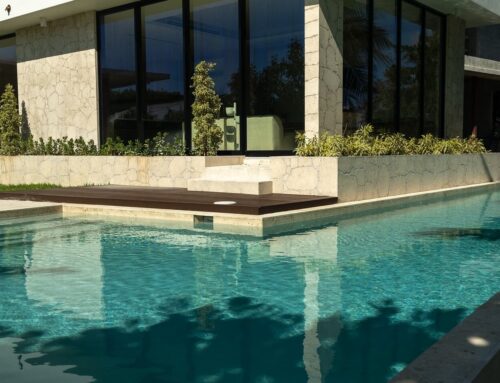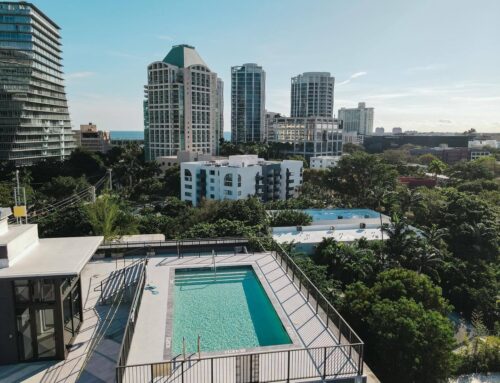Hurricane season is upon us once again. One area of your property that requires special attention during hurricane preparation is your swimming pool. Knowing how to prepare your pool for a hurricane is crucial for minimizing potential damage. Whether it’s reinforcing pool structures, securing equipment, or implementing safety measures, this guide will provide you with essential steps on how to prepare your pool for a hurricane. By following these guidelines, you can protect your patio and pool area effectively when the storm arrives.
Before the Storm: Preparing Your Pool and Outdoor Areas
Do Not Empty Your Pool
Some people may ask, ‘Won’t it overflow if you don’t lower the water level at least?’ It is possible, but not more likely than if there was a patio or plot of grass instead. The design of the pool has always included adequate drainage. The weight of the pool depends on the amount of water that remains in it. An empty pool can ‘float’ or ‘pop’ out of the soil due to the ‘lift’ from excessive groundwater caused by heavy rains.
To prepare for a hurricane, install a siphoning hose in advance. Use a garden hose to run from the pool’s edge down to a point 2 or 3 feet below. Keep the hose handy so you can quickly start the siphon if your pool starts to overflow.
Turn off Electric Power to Swimming Pool Equipment
To prepare the pool for a storm, the circuit breakers on the main electrical panel must be shut off. This will prevent the pump motors, lighting, and heaters from operating during the worst of the storm. When the weather is calm, you can run the pumps and filters, but remember to turn them off when the storm hits.
Protect the Electric Pool Equipment
Wrap the pump motor, time clock, light transformers, and electric heaters into a waterproof membrane. Securely tie the membrane to each device. This will prevent sand or water from entering the units. If flooding is expected, it is best to store these devices in a dry location. This is particularly important for the pool pump, as submerging the motor underwater can cause damage. If needed, take some time to clear the area around the equipment pads of debris, mulch, and leaves.
Remove All Loose Items From the Pool Area
Objects that are not secured, such as toys, chairs, tables, and pool cleaning equipment, can be dangerous during a hurricane. Therefore, they should be kept indoors. Patio furniture should only be thrown into the pool as a last resort. It is best to place the items gently into the pool to avoid damaging the finish. Remove them as quickly as possible to prevent stains. Make sure to secure the skimmer lids to prevent them from becoming projectiles. Check the fence for any loose sections and secure any loose light posts or signage.
Protect the Screen Enclosure
You can prevent some damage to a screen frame by providing a “vent”. This allows the wind to pass through. Pull out the vinyl spines that hold the screen panels to remove them from the opposite side of the enclosure.
Add Extra Chlorine to the Pool
A good swimming pool hurricane preparation suggestion is to add a ‘shock dose’ of liquid or granular chlorine to prevent contamination by debris and excessive stormwater. For optimal results, lower the pH to around 7.2 and then run the filter for several hours after applying the shock treatment.
Do Not Cover the Pool
It is an instinct for people to rush out and cover a swimming pool in preparation for a storm. DON’T DO IT! Storms can bring high winds, and these winds can blow branches and other debris onto the pool cover. After a storm, it is easier to clean up the debris than to replace the expensive cover.
Preparation of Patios and Yards
You can better prepare for a hurricane by maintaining your trees and yard throughout the year. Be sure to trim large trees near your home and watch out for weak branches and those hanging low. Keep limbs under five feet in length and remove Spanish moss to prevent them from becoming weak and breaking during strong winds or heavy rain. Contact your utility company or hire professionals to trim branches near utility lines. Replace gravel and rock pathways with wood chips or shredded bark, as gravel can shred vinyl house lining.
If your pool is located in a lanai or enclosed area with screens, your structure may be at risk of damage. To create an escape from the wind, remove doors and screens. If strong winds are expected and wind damage is likely, you can cut “X” shapes in multiple screens around the swimming pool to reduce wind resistance. These slashes may not be covered by insurance, but rescreening will be much cheaper than replacing the entire frame.
Removing all loose items, such as furniture and plants, from the pool area is a good idea. Gas and charcoal grills can be brought indoors if possible, but they should never be used inside. Anchor heavier and bulkier outdoor items to something solid with rope or chains. Never store propane tanks inside your garage or home. Instead, chain them upright to a secure object away from your house. While some people throw lawn furniture into the pool to prevent it from flying around during strong winds, this can damage the pool’s finish and cause chemical damage to the furniture.
After the Storm
After the storm, check your surroundings for any pool damage. Remove any items that were submerged in the pool as soon as possible. Do not use pool water as a source of drinking or sanitation, as it may be contaminated or still super-chlorinated. Check for leaks or cracks in your pool’s pumps, filters, and plumbing. Before turning on your pumps, check the water and chemical levels, and adjust the valves to the circulatory position. Restore power to the outlets, but make sure to remove all debris and ensure there is no electrical damage before reconnecting power. If you suspect any electrical damage, consider calling an expert before turning the system back on.
As Before the Storm, Do Not Empty the Pool
A pool that is empty after a hurricane may “float” or “pop” out of the earth due to the “lift” from the excessive groundwater caused by the heavy rains which accompanied the storm. Start by draining half of the water and cleaning the pool. Wait until the water table has receded and the ground has become less saturated before draining completely.
Remove Debris From the Pool First
Use a leaf bagger or a leaf rake to remove small debris. Avoid using the vacuum system to remove large debris, which could clog the plumbing. The Leaf Rake type skimmer is the best choice for heavy leaves on the floor or surface. Use a large trashcan on the deck of the pool to empty the net.
Check Electrical Equipment Before Restarting the System
Before turning on the circuit breakers, remove the waterproof plastic membrane. If these devices have been submerged in water, they should be checked by an expert. Turn on the electricity, prime your filter system, and then verify that it is functioning normally. To reduce the water level to the mid-skimmer, either drain the pool or perform a backwash.
If your electricity has not been restored, you can manually vacuum the pool. Use a Leaf Rake powered by a hose or a garden hose for this purpose. Additionally, use a pool brush to promote circulation and help distribute chemicals. Test the water and add chemicals as necessary. By maintaining appropriate pH and chlorine levels, along with daily brushing and skimming, the pool will not deteriorate.
Start the Filter Equipment
Start the filter pump, and run it for several hours every day. Once the water is clear, reset the clock to a daily cycle. As needed, backwash the filter to maintain the flow rate.
Balance the Pool Water Chemistry
Continue to monitor the levels of pH, total acidity, calcium hardness, and conditioners over several days. The water chemistry can be dramatically altered by adding large amounts of dirt or debris. It is crucial to balance the pool to ensure that chlorine can sanitize and prevent staining.
Add Chlorine to the Pool
Add a shock dose of liquid chlorine or granular chlorine to the pool water. This will help prevent contamination by storm debris and excess stormwater. If your pool has been flooded and the water color has changed to the soil, using a flocculant can be beneficial. It will help gather the heavy solids, which can then be vacuumed up. Keep in mind that heavy soil or debris may affect the phosphate levels in your pool. In the case of flooded pools, it is recommended to use a chemical phosphate remover.
Monitor the Pool Operation
After a hurricane, it is crucial to check the system to ensure that everything is working properly and that there are no electrical hazards or pool leaks.
Additional Helpful Resources
There are several safety measures to consider in the event of a hurricane or other tropical storm. Taking safety precautions is crucial during these situations. Fortunately, there are various resources available to help you and your family prepare for such storms.
The National Hurricane Center of the National Weather Service offers valuable tips to ensure that you and your family are well-prepared for the arrival of a hurricane.
The National Weather Service provides the most up-to-date information on hurricanes that are heading your way or still forming.
While there is limited protection for your pool once a hurricane has arrived, being as prepared as possible before and after a hurricane warning can make a significant difference. Always prioritize your safety, as pools can be repaired, but you and your loved ones are irreplaceable.
Trust the Experts at Florida Pool Patio for Hurricane-Ready Pool Preparations
Ensure the safety and longevity of your pool during hurricane season with Florida Pool Patio’s expert tips and high-quality products. Our team of pool professionals understands the unique challenges that Florida’s tropical weather brings, and we are here to help you prepare your pool for any upcoming storms. From durable pool covers to reliable equipment-securing solutions, we have the expertise and resources to safeguard your pool against the potential hazards of hurricane season.
Trust Florida Pool Patio to protect your investment and keep your pool ready for summer fun all year round!
Services We Offer:

